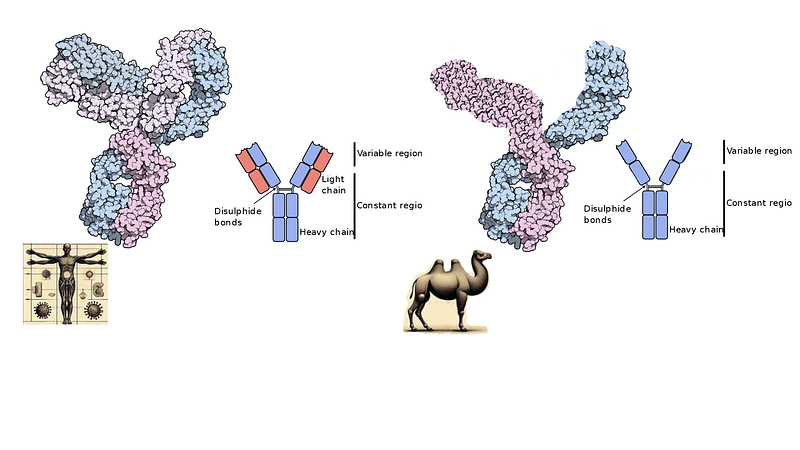The Danger Theory: A Journey Through Immunology and Bias
Written on
Chapter 1: The Quest for Understanding
In a surprising twist, it was discovered that a humanized two-chain antibody elicited pre-existing anti-drug antibodies upon administration in humans. Conversely, a natural two-chain antibody derived from camels did not trigger such responses. This revelation sets the stage for a tale of ignorance and bias within the scientific community, a narrative worth sharing for its educational value.
Once upon a time, a cocktail waitress named Polly found herself eavesdropping on two male professors discussing immunology at her workplace. Frequent patrons, these professors engaged in scientific dialogues rather than the usual topics of sports or politics, drawing Polly's curiosity. As she overheard their conversations, Polly began to grasp the basic principles of immunology, including the adaptive immune response and its recognition of foreign proteins.
One day, Polly's curiosity peaked, prompting her to ask the professors a question that had been bothering her: “How does the body distinguish between 'self' and 'not self' proteins?” To their credit, the professors admitted their lack of knowledge on the subject, which encouraged Polly to delve deeper into the field of immunology.
With their support, Polly pursued higher education, ultimately earning her BA, engaging in graduate studies, and completing a post-doctoral fellowship in Cambridge, England. She then secured a scientist position at the National Institutes of Health (NIH) in Maryland, where her lab was humorously dubbed the "ghost lab," as it lacked the typical experimental bustle. Instead, Polly focused on pondering that fundamental question about protein recognition.
Through extensive reading and contemplation, Polly developed the "danger signal" theory, positing that the adaptive immune system relies on an innate immune response that identifies danger signals rather than a simplistic 'self' versus 'not self' distinction. This groundbreaking theory led Polly to publish her findings, hoping her former professors would be proud of her achievements.
However, her work faced skepticism from the editor of a prominent immunology journal. He dismissed her theory, insisting that such revolutionary ideas couldn't come from a single author, especially not a woman without a collaborative network. In a humorous turn, Polly listed her dog, Galadriel Mirkwood, as a co-author, which allowed her paper to be published despite the editor's initial reluctance.
Polly’s theory sparked excitement among her peers, and she formed a collaboration with Charles Janeway, further advancing her research. Despite the initial pushback, the scientific community began to acknowledge the validity of her arguments, although some remained entrenched in outdated beliefs.
The first video showcases Polly Macpherson's selection as a judge for a celebrity television show, highlighting her prominence in the scientific community and her advocacy for women in science.
Section 1.1: The Impact of Bias in Science
Polly's journey illustrates the biases that women in science often face. A recent article summarized the self–non-self theory's dominance in immunology since the 1950s and the mixed responses to Polly's danger theory, revealing the emotional undertones that often overshadow objective scientific discourse.
Subsection 1.1.1: The Role of Emotion in Scientific Discourse

The authors of this article emphasized their emotional responses to the danger theory rather than presenting empirical evidence. This tendency reflects a broader issue in scientific discussions, where personal biases can cloud judgment and hinder progress.
Section 1.2: The Legacy of Polly Matzinger
Chapter 2: Bridging Science and Reality
As Polly continued to publish her findings, she faced criticism from some segments of the scientific community, particularly those clinging to outdated theories. The cantankerous editor's fury upon discovering her dog was listed as a co-author signified the resistance to change that pervades academia.
The second video features Professor Polly Low discussing Athenian imperial power, drawing parallels to the complexities of modern scientific discourse and the challenges of rethinking established norms.
In my experience within biotherapeutic discovery, I observed that many companies overlooked Polly's insights, leading to suboptimal drug development. The self/not self theory suggested that human therapeutic molecules would be less immunogenic than their non-human counterparts. While sometimes true, this assumption often led to failures in drug efficacy, as seen in the case of Humira, which exhibited significant immunogenicity despite being marketed as a humanized drug.
Through her research, Polly demonstrated that factors beyond mere protein sequence influence immunogenicity. For instance, camelid antibodies, with their unique two-chain structure, provided a promising alternative, exhibiting lower immunogenicity when tested.
The scientific community must evolve by embracing new perspectives, such as Polly's danger theory, rather than clinging to outdated ideologies. The ongoing resistance to her insights underscores the need for a more open-minded approach in scientific inquiry, particularly concerning the contributions of women like Polly Matzinger.